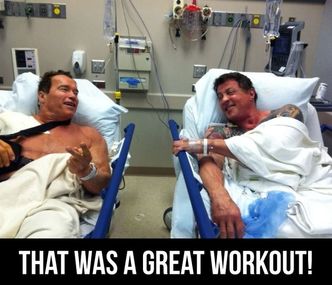 Do you get stiff, sore muscles the day after exercising, or maybe the day after that? Perhaps you find yourself walking downstairs tentatively supporting each step with the bannister rail, “Ouch! Ouch! Ouch!" This is the classic symptom of delayed onset muscle soreness, or DOMS. It’s a sign that you’ve worked your muscles hard - harder than they are used to. But does it indicate strengthening muscles, or is it an the result of damage? The short answer is, it’s a bit of both, but the damage isn’t harmful. A common misconception is that DOMS is caused by a buildup of lactic acid, and that you can flush it away by water or massage. Neither is it the result of inadequate warm-up before or stretching after exercise. The mechanism behind DOMS is thought to be the result of inflammation caused by tiny tears (microtrauma) in the muscle tissue. This damage is one of three key mechanisms that lead to hypertrophy (muscle growth), the other two being mechanical tension (eg weight bearing) and metabolic stress (“the burn”). Some people are motivated by DOMS - “Whoop whoop! I had a great workout yesterday! I can hardly move!!”; whereas others are deterred from exercising, particularly, for example, if they have a physically demanding job and their performance is impaired by the aches and stiffness that follows an exhausting workout. Or if it is simply too demoralising to find climbing stairs a strugggle. Badly timed DOMS can also impair athletic performance. So, what does DOMS tell you about your workout? While it does mean that you’ve pushed yourself, in their review on the effectiveness of DOMS as an indicator of muscle adaptations, Schoenfeld and Contreras wrote, “it remains debatable as to whether DOMS is an accurate gauge of muscle damage” and continued, “although DOMS may provide a general indication that some degree of damage to muscle tissue has occurred, it cannot be used as a definitive measure of the phenomenon”. If you continue at the same level of effort, your experience of DOMS will diminish with each subsequent workout. It is possible get fit without getting DOMS, but for most of us it is part and parcel of the process. If, however, your soreness lasts for more than a few days, it can mean that you’ve overdone your workout, and if you regularly experience serious, long-lasting DOMS, then you risk injuries associated with overtraining.
If DOMS bothers you, then here are my tips to get stronger while minimising soreness:
If in spite of these precautions, you get troublesome DOMS, anything that increases blood flow to the affected muscles - massage, a heat pack or a hot bath - can help to alleviate the soreness. Gentle exercise can also help; although it can initially be uncomfortable, as you get into your stride, it eases off. Once your muscles have cooled down again, the soreness will return, but it does provide short-term relief, and won’t add to the soreness the following day. If your soreness is very painful, then anti-inflammatory drugs such as ibuprofen and aspirin can help to alleviate the symptoms, but I would never recommend painkillers as a first recourse. This will get better on its own. If you want to get strong, DOMS can be your friend. Just think of it as one of those crazy friends that you you enjoy having a wild party with once in a while, but is simply too exhausting to be around all of the time. Comments are closed.
|
AuthorFitness and Pilates instructor with a passion for science. Archives
November 2021
Categories |
 RSS Feed
RSS Feed
